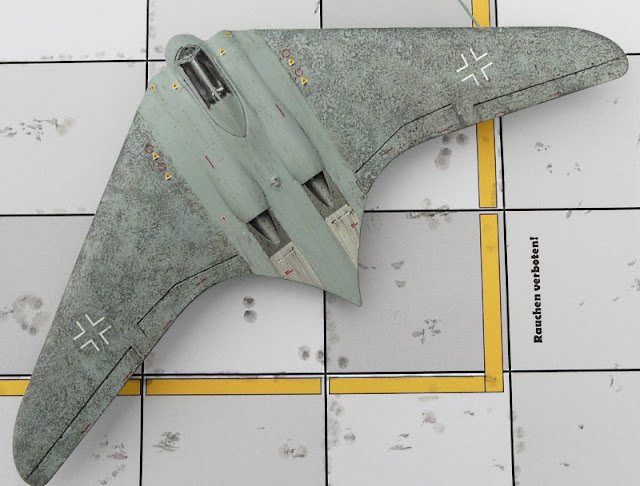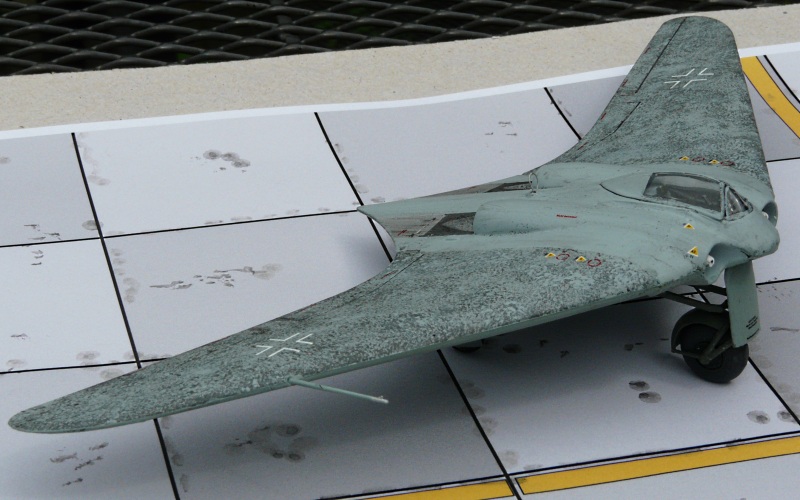
Horten H.IX V3 / Gotha Go 229 V3: my approachCurrently I’m working on a self chosen modelling subject under the title “Too little, too late”, featuring all types of German jets that actually have flown at the end of WWII and have been in my stash for all too long.
I’m very proud to present my interpretation of the Horten IX V3, aka as the Gotha Go 229 V3, as this plant took over the production from the Horten brothers in 1944. I decided to make a totally different version of it than is suggested by Revell and some others on the internet.
Since I’m not very fond of these ‘what if’ interpretations, I decided to go for the original V3 prototype based on the scarce sources I could find. For those who are interested in the choices I made during the building process I will legitimate them below and add more information here than I usually do in a building review ….
If it bores you, than browse directly to the pics of my Go 229 below ;-)
Construction: the prototype and the kit It took me a long time doing research on this plane as it was my intention to get as close to historical correctness as possible.
The first thing that a modeller will notice is the strange colour scheme. Why did I do that and why did I choose these colours?
In April 14 1945 US troop overran a workshop of the Gothaer Wagon Fabrik at Friedrichsroda. There they found an almost complete fuselage of the Go 229 V3 prototype as well parts op the V5, V6 and V7 for which the building was prepared or had just started.
About that time the wings for this plane were discovered in a workshop at Sonnenberg in Germany. It is suggested that they might have belonged to the crashed V2 prototype, that flew 3 times and crashed on February 18 1945, killing its pilot Erwin Ziller.
It took the Americans some weeks to realise that 1 + 1 = 2, and that the wings were suitable or maybe built for the V3 prototype. There is however no hard proof, though careful study of the pics of the plane at the Smithsonian Museum show, that the parts are from at least two Gotha’s. The fuselage had already received at least one layer of paint.

The Americans decided to ship the fuselage and the wings to the US. They tried to reveal the concept and secrets of the plane, that were a mystery to them at the time, though they realised that speed was an essential feature.
There were plans for assembling fuselage and wings and to put it on display for the public, but they never materialised for decades. There were also plans for test flights at Park Ridge, Illinois, but budget cuts in the late forties and early fifties brought these plans to an end. There is a short clip of a V3 test flight on YouTube, but it is believed to be fake.
Finally, the V3 was handed over to the present-day National Air and Space Museum (NASM) in Washington D.C. It still awaits restauration and since most of the plane is made of wood it is in a grave state of deterioration.
Now back to the model. Since the V3 was a prototype I decided to leave the cannons out, closed the gun holes in the leading edge and closed the underwing gun bays. A heavily armed prototype is imho not likely regarding the conditions in which it was found.
Though the kit is very delicate and beautifully detailed, I found the nose edges too sharp edged and the angles too steep, so I sanded it down to make it more flat.
The original colour scheme?After studying every picture of the V3, I could lay my hands on, and after checking Michael Ullmann’s brilliant book “Luftwaffe colours 1935-1945”, I decided that the colours would be the most likely ones to be historically correct were:
RLM 76, for which I used WEM RLM 76 (enamel): for the uppersides of wings and fuselage
RLM 75, Revell 77 Dust Grey (acrylic): for the fine mottling on the wings comparable to the mottling on the original pictures. I carefully stamped it on the surface with a piece of sponge, after thinning, repeated that with RLM 76 when the paint was still wet.
RLM 65, Tamya XF-23 light blue (acrylic): for the undersides
Tamya X-10 Gun metal and XF-16 aluminium for the panels directly behind the jet exhausts
RLM 02 and Olive Green (acrylic) for the insides.
Decals and weatheringAfter the puzzling search for the “most-correct-as-possible colours” I stumbled upon another problem: the decals. I never liked the double swastika’s on the tail and looked at them with suspicion. It all seemed so exaggerated to me: both the size and the fact that there were two of them so close to eachother. There was something wrong with it, but what exactly?
I then found a forum where this matter was discussed and somebody quoted a witness there, who saw the plane a few weeks after its arrival in the US: there were no swastika’s on it. So they were painted on the plane in…. the US! I decided to leave them out.
Then I looked closely at the enlarged pics of the wings again. To my astonishment I noticed that the “Balkenkreuz” was too big and on the wrong side of the wing and placed too much inboard. On top of that I noticed that the type of balkenkreuz was not applied anymore when the V3 was build!
I assume that the witnes was right: the painter was obviously not familiar with the RLM-directions for national insignas and identification marks on Luftwaffe planes in the late war.
So I decided to use some of the decals that come with the kit and some from my spares box that match the 1944-45 era. Registration numbers were not applied, the stencils probably were. There are no indications that the dotted walkway lines were painted on this prototype as it didn’t receive its final finish, so I left them out.
As for the weathering: the plane never flew, nor were the engines tested after building them in the fuselage. So one could say that the plane was “factory fresh”. Therefore I decided to apply some wash on the panellines and the edges of the flaps and gunbay doors and leave it at that.
ConclusionI started this article by stating that I’m not very fond of these ‘what if’ interpretations. But now that the thing is ready I realise that I myself made a ‘what if’ kit after all: what would this plane have looked like when the V3 prototype would have been completely built in 1945?
This Revell kit (nr. 04312) really is a success and great fun to build. Well detailed, with delicate plastic parts, superb decals and a reasonable pricing: it make the kit recommendable indeed. A quick view on the internet shows that the kit has offered modellers all over the world a fair chance to use their fantasy.








 References:1. Background information:
References:1. Background information:http://www.ipmsstockholm.org/magazine/1999/02/stuff_eng_detail_hoix.htm
http://www.militaryfactory.com/aircraft/detail.asp?aircraft_id=105
http://de.wikipedia.org/wiki/Horten_H_IX
http://airandspace.si.edu/collections/artifact.cfm?id=A19600324000
http://www.warbirdforum.com/horten2.htm
http://einestages.spiegel.de/static/topicalbumbackground/4028/hitlers_traum_vom_tarnbomber.html
2. Pictures and videoclipshttp://www.youtube.com/watch?v=bFHe4jQIbm8
http://www.youtube.com/watch?v=BkevU3o5Z2Q&feature=related
http://www.youtube.com/watch?v=b8ap2xXdOzg&feature=related
http://www.youtube.com/watch?v=JBnBSJ9bz3A&feature=related
http://www.youtube.com/watch?v=oHF6DjW60NY
History Channel: Secret Luftwaffe Aircraft of WWII (documentary)